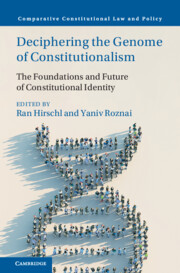Book contents
- Deciphering the Genome of Constitutionalism
- Comparative Constitutional Law and Policy
- Deciphering the Genome of Constitutionalism
- Copyright page
- Contents
- Figures
- Contributors
- Preface
- Acknowledgments
- Introduction
- Part I Foundations, Theory, and Concepts
- 1 Rousseau’s Sovereignty and the Concept of Constitutional Identity
- 2 Constitutional Identity
- 3 Constitutional Identity as Discourse
- 4 Constitutional Identity and Constitutional Revolution
- 5 The Death of Constituent Power
- 6 Constitutional Identity as a Source of Ontological Security
- 7 The Crisis in, and of, Constitutional Identity
- Part II Comparative Perspectives
- Part III American Constitutionalism and Constitutional Identity
- Part IV Emerging Trends
- Index
- References
2 - Constitutional Identity
Cracking the Genetic Code of the Constitution
from Part I - Foundations, Theory, and Concepts
Published online by Cambridge University Press: 14 March 2024
- Deciphering the Genome of Constitutionalism
- Comparative Constitutional Law and Policy
- Deciphering the Genome of Constitutionalism
- Copyright page
- Contents
- Figures
- Contributors
- Preface
- Acknowledgments
- Introduction
- Part I Foundations, Theory, and Concepts
- 1 Rousseau’s Sovereignty and the Concept of Constitutional Identity
- 2 Constitutional Identity
- 3 Constitutional Identity as Discourse
- 4 Constitutional Identity and Constitutional Revolution
- 5 The Death of Constituent Power
- 6 Constitutional Identity as a Source of Ontological Security
- 7 The Crisis in, and of, Constitutional Identity
- Part II Comparative Perspectives
- Part III American Constitutionalism and Constitutional Identity
- Part IV Emerging Trends
- Index
- References
Summary
The chapter describes first the importance of Jacobsohn’s work to constitutional theory in general as it relies on the ideas of dynamism, fluidity, disharmony and imperfection to describe a constitution’s functioning. It then focuses on the German constitutional conflict on binding electoral gender quotas in order to illustrate the pertinence of his theory that describes so aptly the functioning of a constitution. It concludes with the finding that, in terms of constitutional theory, Jacobsohn has indeed cracked the genetic code of a constitution.
- Type
- Chapter
- Information
- Deciphering the Genome of ConstitutionalismThe Foundations and Future of Constitutional Identity, pp. 34 - 43Publisher: Cambridge University PressPrint publication year: 2024

